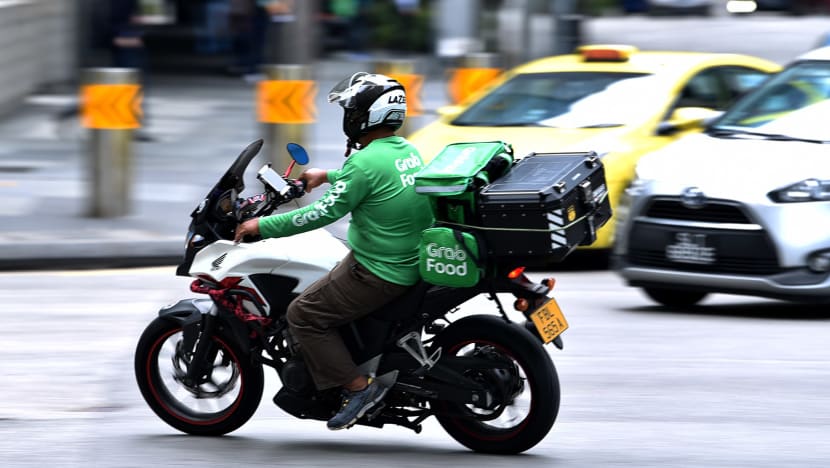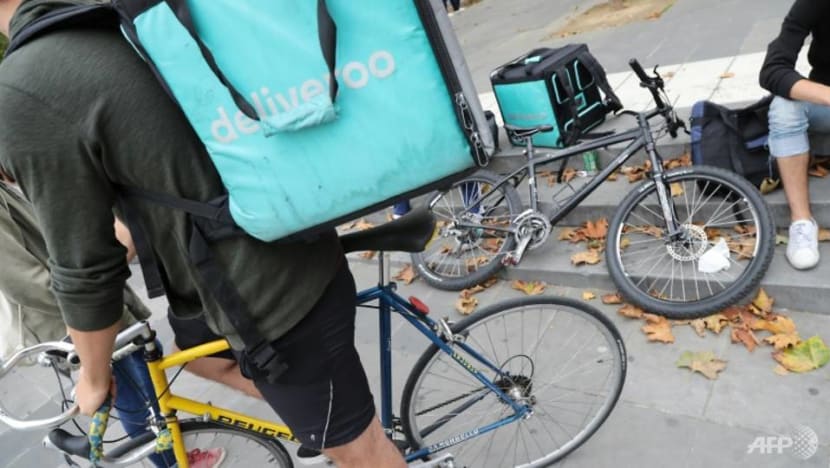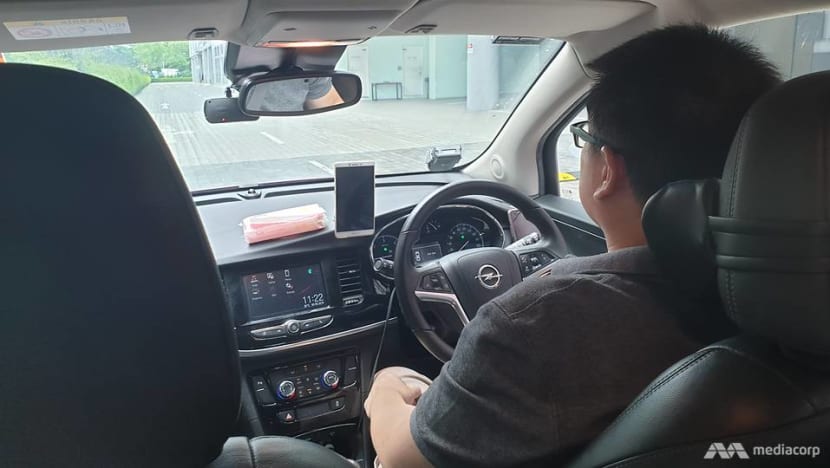commentary Commentary
Commentary: The gig economy – a surprise boost from the pandemic and in Singapore, it’s not going anywhere
Delivering food or ride-hailing jobs may have a poor reputation as unstable and low-skilled but NUS economist Sumit Agarwal says it is important especially when times are tough.

File photo of a Grab Food delivery driver (Photo: Jeremy Long)
SINGAPORE: Around the world, the COVID-19 pandemic has dashed hopes of a better future.
In Asia Pacific, 81 million jobs were lost in 2020, according to a new report by the International Labour Organisation.
The unemployment rate in many countries has risen from a single digit to double digits.
But it still remains in the single digits for Singapore. In fact, Singapore’s unemployment rate fell for the first time in 2020 to 3.3 per cent in November, while the citizen unemployment rate fell to 4.7 per cent.
READ: Commentary: Singaporeans hit hard by COVID-19 still have job opportunities, but need to take these
The fiscal support given by the Government has cushioned the fall.
Since the pandemic, the Singapore Government had set aside over billions to stimulate the economy and keep jobs through measures like the Jobs Support Scheme (JSS) and the Jobs Growth initiative, including at Budget 2021.
The gig economy, meanwhile, provided lifelines keeping many afloat. During the circuit breaker, workers from the travel and tourism industries turned to food-delivery gig jobs to boost their incomes.
One year since the pandemic, why do users, riders and restaurants alike still have complaints about food delivery apps? A business professor and a ride-hailing app founder weigh in on CNA's Heart of the Matter podcast:
THE LURE OF THE GIG ECONOMY
Gig economy work has been popular in Singapore for some years now, even before the pandemic.
Many here have turned to freelance work while waiting for permanent employment or use it to supplement their income while dabbling in ventures, in education or entrepreneurship.
The gig economy also provides an alternative source of income for those less suited to full-time work.
According to the Ministry of Manpower, the number of freelancers in Singapore stood at about 211,000 in 2019 – about 10 per cent of all employed residents - up from 200,000 in 2016, showing a steady increase.
READ: Commentary: Don’t be too quick to write off the sharing economy, even with COVID-19
It is the same around the world – Forbes reports that 36 per cent of Americans engage in some sort of flexible work and companies too are hiring these full-time part-timers to keep labour costs low.

Part of this revolution has been powered by technology – the rise of apps that allow you to order anything you desire with your phone.
This came into even sharper focus during COVID-19.
Throughout the circuit breaker and thereafter, there has been an increased reliance on these services, although ride-sharing apps such as Grab did see a fall in its transport business in 2020 as people commuted less.
For workers traditionally at the lower end of the skills ladder – this was too good an opportunity to miss. Drivers and food delivery folks from companies such as Grab could reportedly make thousands a month.
In a non-gig world, these workers may have been confined to fixed jobs as cashiers or security staff, cleaners – with long hours and potentially lower pay – or no work at all.
READ: Commentary: Maybe private-hire drivers and food delivery riders don’t want full-time jobs
All this activity has added to the coffers of platform companies – and by extension to the economy.
Take for example, Grab’s net revenue, which grew 70 per cent in 2020, fuelled by a surge in its food-delivery business. The tech giant is even bringing forward its IPO goals to this year. That’s not a bad thing if the company goes on to create more high-value jobs for Singaporeans.
MORE SUPPORT FOR THE GIG ECONOMY
What lessons can we take away from this phenomenon? The gig economy has done well in cushioning citizens from unemployment, even if this is not necessarily across the board.
Maria Figueroa, Director of Labour and Policy Research at Cornell University's School of Industrial and Labour Relations told media that during this crisis, “Those who offer online services may fare better than freelancers with incomes tied to events”.
READ: Commentary: Companies and workers, forget life before COVID-19. Budget 2021 will help us prepare for life after it
On the whole though, this asset-light model make companies like Grab, Deliveroo and Airbnb more resilient to economic fluctuations.
The question of course is what more can be done to support these workers – who are at the mercy of fluctuations in the market.
The recent UK court ruling that Uber drivers should be treated like workers rather than independent contractors holds promise of shifts underway towards stronger protections and better recognition.

In Singapore, measures supporting training programmes and bolstering CPF savings of gig economy workers were rolled out last year.
Ideally, there would be schemes for gig workers to undergo training in skills tailored to their fields of freelance work that creates potential for progress within the sector.
Gig workers can be trained to interact better with customers. They can also learn how to generate business leads as a gig worker, and start their own gig business.
Such a move will be in line with the Government’s push on SkillsFuture, to build a skilled, relevant and future-ready workforce.
The Government can also help ensure that gig workers have adequate social safety nets.
READ: Commentary: Yes, you can peak in your career in your sixties
Workers who stay long-term in the gig economy may end up accumulating little contributions in their Central Provident Fund (CPF), impacting their retire adequacy, housing affordability and healthcare provisions.
Businesses that rely on a freelance army should also set aside funds towards a CPF contribution scheme for gig workers.
For instance, from 2020, freelance workers hired by the Government came under the Contribute-As-You-Earn (CAYE) pilot scheme – a portion of the payment for their services are automatically transferred to their Medisave accounts.
It is time to extend this to gig workers in the private sector too. This will help both the private sector employers and also the employees to participate in the gig economy.
Moves to enhance collective bargaining through the establishment of a Delivery Champions Association last December and National Private Hire Vehicles Association in 2016 are also worth watching for results.
A WASTE OF TALENT AND RESOURCES?
Some may say a push for the gig economy may be “a waste of talent”. These gig workers could be working in full-time jobs with skills ladders they can climb instead.

But seeking jobs is a matching of expectations. The gig job disdained by some may be a dream job desired by others who relish or need the flexibility.
Workers can devote more time to their young children or older parents and not waste money on day care or elderly support respectively.
Finally, how do we deal with workers who want to give up gig jobs and move to a nine-to-five job as a technician or an analyst?
As an economist, I believe in markets.
So let the demand and supply forces determine the wages and other benefits for the gig workers. Moreover, if there are no frictions, people should be able to move back and forth between the gig and the traditional economy.
READ: Commentary: Guaranteed next-day deliveries in South Korea are coming at a heavy price
READ: Commentary: Giving up petrol cars is a lot more difficult for parents
One may wonder whether gig workers lose out if companies change their hiring policy, if they have no marketable skills thereafter. This can be costly to the gig workers, and as a result, should the Government discourage gig workers?
It is hard to speculate on all the jobs of the future and the skill requirements. Nobody could have imagined life as a “influencer” or an app-designer just 10 years ago.
So, how gig workers’ skills evolve and how valuable they will be in the future economy are hard to predict.
But on the question of whether there is a role for the government, the answer is s resounding yes. As a society, we should ensure all citizens should have a strong social safety net.
SIGN UP: For CNA’s Commentary newsletter so you get our best offerings each week
Sumit Agarwal is the Low Tuck Kwong Distinguished Professor of Finance, Economics and Real Estate at the National University of Singapore (NUS) Business School. He is also the co-author of Kiasunomics and Kiasunomics 2. The opinions expressed are those of the writer and do not represent the views and opinions of NUS.












